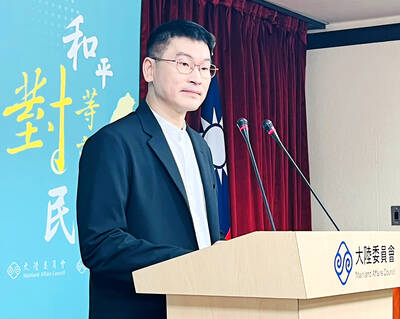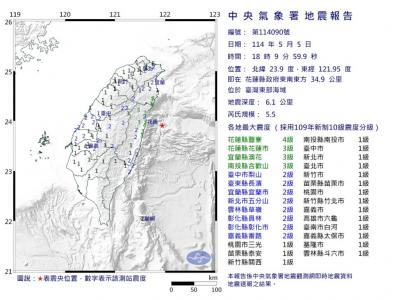Deep in farming country in rural Chiayi County, a brand new six-lane road, complete with streetlights, gardens and fountains, cuts through acres of fertile farmland. Less than a kilometer away stands an imposing high-speed rail station, about a half-hour drive from central Chiayi City.
The road is almost entirely empty. The occasional blue truck passes by, carrying agricultural produce, or in one case, cages filled with angry squawking chickens. The fountains spray jets of water listlessly on a timer, impressing nobody but the passing stray dog.
Hidden behind a tall metal wall along Gugong Boulevard (故宮大道) lies the reason why the new roads, pipelines and transmission towers were built last year, at a cost of more than NT$1 billion (US$31.2 million) to taxpayers. It’s the construction site for the new branch of Taipei’s National Palace Museum (NPM).
“Six hundred and twenty days and counting” blinks a huge electronic urn-shaped billboard erected by the county government. The number is in reference to President Ma Ying-jeou’s (馬英九) pledge that the NT$7.9 billion NPM Southern Branch would open by spring 2012 at the latest, after years of delays.
County officials are hoping the new museum, the only branch of the NPM outside Taipei, will convince more tourists to visit the agriculture-and-tourism-based county, best known for its iconic attraction Alishan. Already, early signs of new development can be seen along the new roads leading up to the construction site.
“Our wish is that this new branch, with its new design and modern features, will exceed the original museum in Taipei,” said Kang Wen-lin (康文玲), director-general of the county’s cultural affairs department. “We want it to draw tourists, not just from within Taiwan, but from around the world.”
However, it now seems that this optimism will have to be put on hold, after NPM officials admitted that the opening date for the main museum building would be pushed back at least another three years, to 2015, and the surrounding grounds another five years, to 2017.
Officials say the holdup has resulted from problems with contractors and concerns over flooding in the area. In 2008, two major contractors responsible for design and consulting on the project, Antoine Predock Architects and Lord Cultural Resources, were dismissed, allegedly because of cost and construction time overruns.
A quick peek over the wall shows dozens of acres of weeds and wild unkempt grass. Missing from the picture are the excavators, construction crews and building supplies that usually accompany a major development, especially one backed by an election pledge from the president.
The empty grounds stand in stark contrast to what the museum is supposed to become. When finished, it will include a 34,000m2 main building with Aboriginal and Taiwanese features, as well as an additional 58 hectares of gardens, rivers and performance areas. The layout also includes exhibition areas for pottery, textiles, tea and Buddhist art as well as walking paths and two man-made lakes.
News that their prized project has once again been put on hold has shocked local residents and tourism operators, who say they trusted Ma to follow through on the pledge he made for a 2012 opening when he was campaigning for a Chinese Nationalist Party (KMT) candidate in the local elections last year. Some bet their livelihoods on the promise.
Wang San-hwa (王三華), the director of Chiayi’s hostel development association, an industry group that represents 150 hostels across the county, said some of the land around the building site had already been purchased by hotel and hostel operators hoping to turn the sleepy farming region into a major tourist attraction.
“Businesses were investing in the area because of Ma’s promise that the museum would open within the next two years,” he said. “This latest delay will affect the tourism industry in all of southern Taiwan and it will increase the economic disparity between the city and the countryside.”
A quick trip through Chiayi County shows the precarious state of the county’s tourism sector, once a powerful engine for the region’s growth. Typhoon Morakot last August, which collapsed mountainside roads and bridges, reduced the number of tourists and sightseers visiting Alishan to a trickle.
While the mountain is still a must-see destination for Chinese tour groups traveling around Taiwan, the county government says that most only stay for two to three hours, just enough to snap up boxes of famed Alishan tea and take a quick picture of its winding railways and ancient trees. Most do not stay the night.
Instead, people like Wang, who also runs a small hostel in the county providing cultural and ecological tours, have been hoping to draw a clientele more interested in spending a few days to explore the county’s historical streets, ancient buildings and pristine forests. The very type who would be drawn by a world-renowned museum.
“This museum will provide our tourism sector with benefits for years and years to come,” he said. “But only during elections do we see our politicians deal with this issue. As soon as the elections end, this museum is once again forgotten.”
The delay could have far-reaching implications for the region’s development. Tourism operators say that when built, the new museum would give the county a second international attraction, forming a comprehensive travel package that would allow more tourism dollars to stay in the local economy, instead of flowing down to neighboring Tainan or Kaohsiung cities.
“The new museum could end up transforming tourism in the entire county. While Alishan will still be an ecological draw, the NPM Southern Branch could become a cultural hub,” said Yapsuyongu Tiakiana, the former operator of the Janfusun Fancyworld theme park, who just recently opened an Aboriginal cultural village near Alishan.
He is optimistic about the area’s future prospects, envisioning a day when visitors will stay two or three days to see all of the county’s tourist attractions. However, based on the overflowing weeds and abandoned building materials at the building site, it seems like those cheerful thoughts may have to wait a little bit longer.

An essay competition jointly organized by a local writing society and a publisher affiliated with the Chinese Communist Party (CCP) might have contravened the Act Governing Relations Between the People of the Taiwan Area and the Mainland Area (臺灣地區與大陸地區人民關係條例), the Mainland Affairs Council (MAC) said on Thursday. “In this case, the partner organization is clearly an agency under the CCP’s Fujian Provincial Committee,” MAC Deputy Minister and spokesperson Liang Wen-chieh (梁文傑) said at a news briefing in Taipei. “It also involves bringing Taiwanese students to China with all-expenses-paid arrangements to attend award ceremonies and camps,” Liang said. Those two “characteristics” are typically sufficient

A magnitude 5.9 earthquake that struck about 33km off the coast of Hualien City was the "main shock" in a series of quakes in the area, with aftershocks expected over the next three days, the Central Weather Administration (CWA) said yesterday. Prior to the magnitude 5.9 quake shaking most of Taiwan at 6:53pm yesterday, six other earthquakes stronger than a magnitude of 4, starting with a magnitude 5.5 quake at 6:09pm, occurred in the area. CWA Seismological Center Director Wu Chien-fu (吳健富) confirmed that the quakes were all part of the same series and that the magnitude 5.5 temblor was

The brilliant blue waters, thick foliage and bucolic atmosphere on this seemingly idyllic archipelago deep in the Pacific Ocean belie the key role it now plays in a titanic geopolitical struggle. Palau is again on the front line as China, and the US and its allies prepare their forces in an intensifying contest for control over the Asia-Pacific region. The democratic nation of just 17,000 people hosts US-controlled airstrips and soon-to-be-completed radar installations that the US military describes as “critical” to monitoring vast swathes of water and airspace. It is also a key piece of the second island chain, a string of

The Central Weather Administration has issued a heat alert for southeastern Taiwan, warning of temperatures as high as 36°C today, while alerting some coastal areas of strong winds later in the day. Kaohsiung’s Neimen District (內門) and Pingtung County’s Neipu Township (內埔) are under an orange heat alert, which warns of temperatures as high as 36°C for three consecutive days, the CWA said, citing southwest winds. The heat would also extend to Tainan’s Nansi (楠西) and Yujing (玉井) districts, as well as Pingtung’s Gaoshu (高樹), Yanpu (鹽埔) and Majia (瑪家) townships, it said, forecasting highs of up to 36°C in those areas